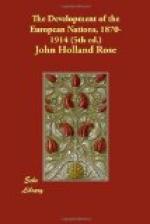[Illustration: THE DERVISH ATTACK ON MACDONALD.]
[Illustration: THE BATTLE OF OMDURMAN.]
Only on the north, where the camel-corps fell into an awkward plight among the rocks of the Kerreri slope, had the attack any chance of success; and there the shells of one of the six protecting gunboats helped to check the assailants. On this side, too, Colonel Broadwood and his Egyptian cavalry did excellent service by leading no small part of the Dervish left away from the attack on the zariba. At the middle of the fiery crescent the assailants did some execution by firing from a dip in the ground some 400 yards away; but their attempts to rush the intervening space all ended in mere slaughter. Not long after eight o’clock the Khalifa, seeing the hopelessness of attempting to cross the zone of fire around el-Gennuaia, now thickly strewn with his dead, drew off the survivors beyond the ridge of Gebel Surgham; and those who had followed Broadwood’s horse also gave up their futile pursuit, and began to muster on the Kerreri ridge.
The Sirdar now sought to force on a fight in the open; and with this aim in view commanded a general advance on Omdurman. In order, as it would seem, to keep a fighting formation that would impose respect on the bands of Dervishes on the Kerreri Hills, he adopted the formation known as echelon of brigades from the left. Macdonald’s Sudanese brigade, which held the northern face of the zariba, was therefore compelled to swing round and march diagonally towards Gebel Surgham; and, having a longer space to cover than the other brigades, it soon fell behind them.
For the present, however, the brunt of the danger fell, not on Macdonald, but on the vanguard. The 21st Lancers had been sent forward over the ridge between Gebel Surgham and the Nile with orders to reconnoitre, and, if possible, to head the Dervishes away from their city. Throwing out scouts, they rode over the ridge, but soon afterwards came upon a steep and therefore concealed khor or gulley whence a large body of concealed Dervishes poured a sharp fire[415]. At once Colonel Martin ordered his men to dash at the enemy. Eagerly the troopers obeyed the order and jumped their horses down the slope into the mass of furious fanatics below; these slashed to pieces every one that fell, and viciously sought to hamstring the horses from behind. Pushing through the mass, the lancers scrambled up the further bank, re-formed, and rushed at the groups beyond; after thrusting these aside, they betook themselves to less dramatic but more effective methods. Dismounting, they opened a rapid and very effective fire from their carbines on the throngs that still clustered in or near the gulley. The charge, though a fine display of British pluck, cost the horsemen dear: out of a total of 320 men 60 were killed and wounded; 119 horses were killed or made useless[416].
[Footnote 415: Some accounts state that the Lancers had no scouts, but “an officer” denies this (Sudan Campaign, 1896-99, p. 198).]




